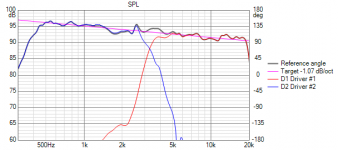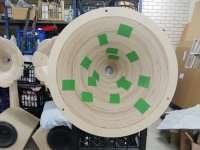I have BMS. Mark and Peter Morris have already written something about subjective comparison
Im also not sure if I asked you before. What you take on the BMS vs 464? (Hifi wise)
There is a review of the driver in the October issue of voice coil magazine. Unfortunatley the link that they mailed me doesn't work. Maybe it works for other subscribers though.
Regards
Charles
Piff I have no access to it.
In the meantime I could access it.
Vance D measured the driver on the prototype horn that we have seen posted here before. I have not read the test properly but two things were very interesting: On that horn the lower -3dB cutoff frequency was 300 Hz !!!! Throughout the midrange the deviation from linear amplitude response was below +- 2 dB. In the HF it was about +- 2.5 dB
I will read it properly again later on.
That prototype horn (which will most probably never be manufactured in quantities anyway) does not have a really smooth contour and therefore I guess there would be room for improvement.
Regards
Charles
Vance D measured the driver on the prototype horn that we have seen posted here before. I have not read the test properly but two things were very interesting: On that horn the lower -3dB cutoff frequency was 300 Hz !!!! Throughout the midrange the deviation from linear amplitude response was below +- 2 dB. In the HF it was about +- 2.5 dB
I will read it properly again later on.
That prototype horn (which will most probably never be manufactured in quantities anyway) does not have a really smooth contour and therefore I guess there would be room for improvement.
Regards
Charles
Piff I have no access to it.
signing up for a subscription is free, I would recommend doing so its a good magazine.
signing up for a subscription is free, I would recommend doing so its a good magazine.
thanks! Initially I thought its only for companies.
In the meantime I could access it.
Vance D measured the driver on the prototype horn that we have seen posted here before. I have not read the test properly but two things were very interesting: On that horn the lower -3dB cutoff frequency was 300 Hz !!!! Throughout the midrange the deviation from linear amplitude response was below +- 2 dB. In the HF it was about +- 2.5 dB
I will read it properly again later on.
That prototype horn (which will most probably never be manufactured in quantities anyway) does not have a really smooth contour and therefore I guess there would be room for improvement.
Regards
Charles
Yes I just read it and it amazes me that contrary to the specs it goes smooth up to 20k...
Why the specs say 18k?!?!
Hey guys, just wanted to say the issues I was having with the dcx464 being crossed at 3kHz, vs the 4594he at 6.3kHz....appear to be solely about my fledgling synergy attempts.
As I'm slowly ironing out the synergy build, the dcx464 keeps shining brighter and brighter
I'm almost ready for trying to find crossover sweet spot....I think I saw in Voice Coil, that Bennet P. mentioned it being around 4kHz.
Any preferences forming yet?
As I'm slowly ironing out the synergy build, the dcx464 keeps shining brighter and brighter
I'm almost ready for trying to find crossover sweet spot....I think I saw in Voice Coil, that Bennet P. mentioned it being around 4kHz.
Any preferences forming yet?
My first cut at a passive X/O came out a bit lower than that.

Whats the XO used for this!?!
I'd guess Bennett's suggestion is based around a full DSP solution. That would simplify the design significantly and maximise driver output, which is paramount in prosound. My design is for a commercial domestic HiFi system.
That makes sense. Good luck with your design, and whatever horn you are using looks super !
William, what waveguide you used?
This:
It's 480mm dia and 250mm deep, CD.
Attachments
Last edited:
That makes sense. Good luck with your design, and whatever horn you are using looks super !
Thanks Mark.
Whats the XO used for this!?!
Designed specifically for the horns pictured above. The key component and the trickiest to get right was the notch filter on the top end of the mid drivers response. I spent quite a bit of time finessing that area to get the phase response at crossover correct.
This is not a driver to learn passive crossovers on. If you are not experienced in passive crossover design stick to DSP.
Designed specifically for the horns pictured above. The key component and the trickiest to get right was the notch filter on the top end of the mid drivers response. I spent quite a bit of time finessing that area to get the phase response at crossover correct.
This is not a driver to learn passive crossovers on. If you are not experienced in passive crossover design stick to DSP.
Thanks for the tip.
The overlap does help eh?
Your freq looked really cool indeed
Very curious about the Voice Coil comment...
Pretty hard distortion spike on midrange at 2k
- Home
- Loudspeakers
- Multi-Way
- B&C DCX464

